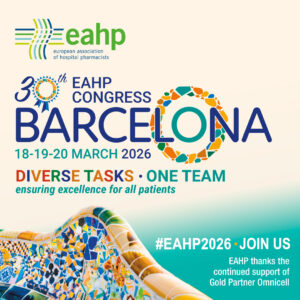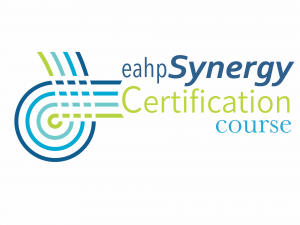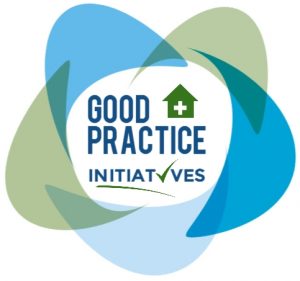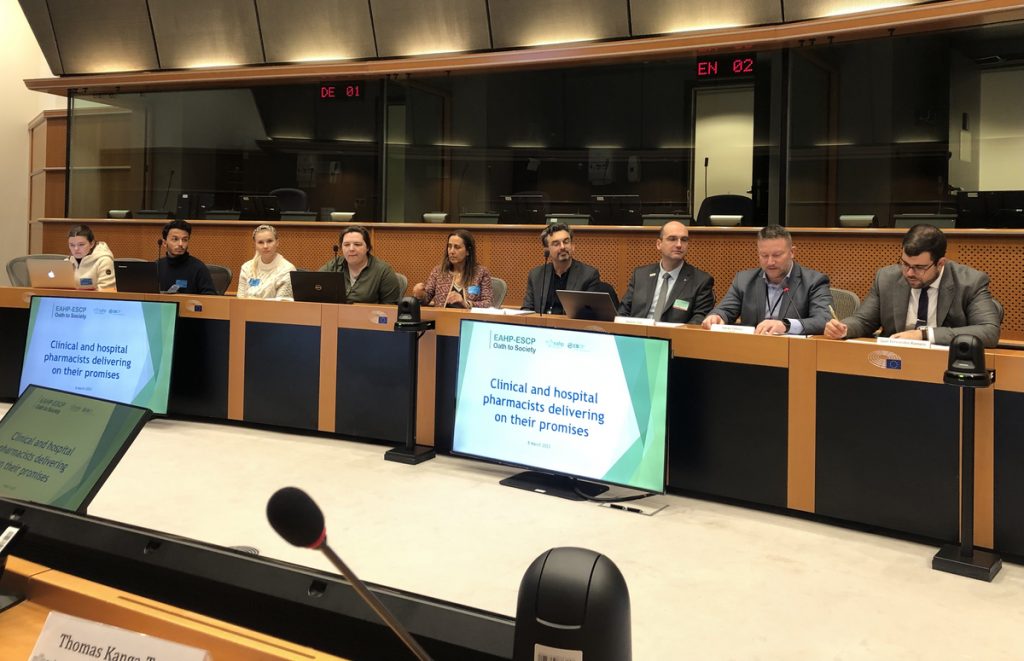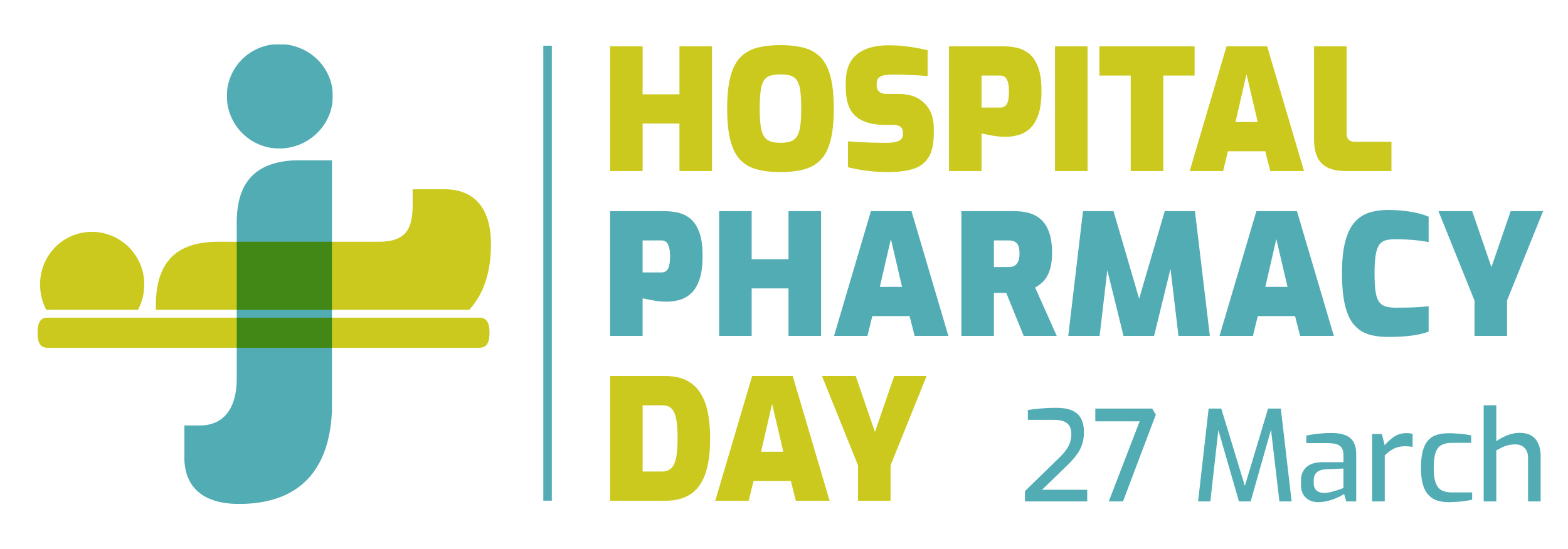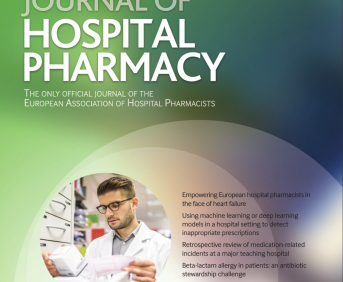IMPLEMENTATION OF AN APPOINTMENT MANAGEMENT MODULE APPLIED TO THE OUTSIDE PATIENT AREA
European Statement
Patient Safety and Quality Assurance
Author(s)
JUDIT PERALES PASCUAL, ANA PÉREZ LÓPEZ, HERMINIA NAVARRO AZNAREZ, ELENA HERRANZ BAYO, MARIA PEREZ MORENO, CARLOS-IGNACIO DIAZ CALDERON HORCADA, Mª REYES ABAD SAZATORNIL
Why was it done?
In 2019 the UPEX attended a large volume of patients without a scheduled appointment, long waits were generated and the pharmacotherapeutic follow-up was complicated. The purpose was to implement an appointment management module to avoid crowds, excessive waiting times, allowing better organizational management of care and knowledge of patients in each type of consultation.
What was done?
An outpatient is a patient who goes to the outpatient unit of their Hospital Pharmacy Service to collect a drug for hospital use/diagnosis or foreign drug (it will be administered without health personnel intervention).
An appointment management system was implemented in accordance with the objectives of the SAMPA project (Service for Registration and Promotion of Adherence to Medicines for Elderly Patients), included in the European STOPandGo project.
How was it done?
Creating a cross-cutting system for the entire clinical circuit from prescription to dispensing involved a great deal computer involvement. Although it began to be used in November 2018, it was not used by the mostly part of prescribing doctors until the end of 2020.
Now, when the patient leaves medical consultation, he/she will go to the pharmacy and will be seen by a pharmacist. Besides, the program will propose a return appointment when it calculates that the patient has a week’s worth of medication, thus preventing the patient from running out of medication. The pharmacist will decide if the patient needs pharmacotherapeutic follow-up.
What has been achieved?
In 2019, 5 services cited patients while in 2020 it was 14; the percentage of patients attending pharmacy cited increased from 73.2%(2019) to 79.4%(2020).
Currently, the pharmacist knows in advance which scheduled patients he has and can establish a better organizational care management and determine in advance if the patient needs a close pharmacotherapeutic follow-up. Additionally, with this system an average waiting time of 03:55min was achieved (in 2019 appointments with waits >30min were recorded).
What next?
The implementation of the appointment management system has made possible to achieve better organizational management of care,avoid crowds,excessive waiting times, and provide better patient care and pharmacotherapeutic follow-up. The proposed solution can be extended to other hospitals.
Novel vaccine clinical trials in Africa
European Statement
Education and Research
Why was it done?
The Partnership for Research on Ebola VACcination (PREVAC) established a randomised, double-blind, placebo-controlled, phase 2 study evaluating three vaccine strategies against Ebola in healthy volunteers in four West African countries. Pharmacists from all PREVAC participating country teams were introduced at collaborative calls where the study protocol was presented.
What was done?
UK Hospital Pharmacists with clinical trials experience worked with London School of Hygiene and Tropical Medicines (LSHTM) research teams in Sierra Leone and pharmacists from there, France, Guinea, US and Liberia to establish the Standard Operating Procedures and protocols required to compare two novel vaccines for Ebola Virus Disease (EVD).
How was it done?
The trial pharmacy teams met virtually each month to discuss the development of Standard Operating Procedures to store and prepare the vaccines. We started by ensuring an appropriate space within the research site was identified for the pharmacy. We advised on the equipment required for aseptic preparation, temperature monitoring and controlled storage of Investigational Medicinal Products (IMP). Solar fridges were identified for IMP storage at 2-8 deg C and ambient 15-25 deg C products, with freezers being run on generators. We developed protocols and documents for temperature monitoring and back-up plans for the failure of cooling devices. I set up trial dispensing procedures to enable preparation of the vaccine for ‘blind’ administration. The local pharmacy team advised on the equipment required to work aseptically. Sourcing specialist equipment, much of which is not available locally, takes considerable time so this work was undertaken several months before participant recruitment began, ensuring that it could be calibrated and validated before receipt of IMP.
What has been achieved?
Pharmacists from France and the UK have worked with local colleagues to develop best practice for clinical trials in resource-limited, tropical settings. This learning is invaluable for the future development of vaccines.
https://www.semanticscholar.org/paper/Partnership-for-Research-on-Ebola-VACcination-of-a-Badio-Lhomme/e70c6224c89e28481ea278ca43ee51d163645fea
What next?
Clinical trials must be carried out in the context in which the investigational medicinal product is intended for use, at standards required to achieve EMEA and FDA authorisations. EU hospital clinical trials pharmacists working with university research teams can support their pharmacy colleagues in these settings to ensure optimisation of IMP storage, handling and preparation with accurate record keeping..
Clinical impact assessment of pharmaceutical intervention during pharmaceutical consultation of oral therapy-treated cancer patients
Pdf

European Statement
Clinical Pharmacy Services
Author(s)
Justine Touchard, Elisabeth Angelier, Isabelle Ferry, Marion Lafay, Jean-Stéphane Giraud, Caroline Giard, Mallory Friou, Laurence Escalup, Thomas Genevée
Why was it done?
For more than 15 years, within the Institut Curie, a pharmaceutical consultation (PC) has been offered to patients undergoing anticancer oral therapy, in addition to a medical announcement consultation and a nurse consultation. The pharmacist secures and optimises drug management through a pharmaceutical analysis of the prescription, an explanation to the patient of drug intake and management of the main side effects.
What was done?
The aim is to assess the Clinical Impact (CI) of Pharmaceutical Interventions (PI).
How was it done?
From 1 January 2020 to 17 March 2020, two types of PI could be collected during each PC. One concerned the prescriber and problems of prescription, while the other concerned patients. Patients could misunderstand some of the information explained by their oncologist. The evaluation of the CI of these PI has been documented by an oncologist based on the Cléo scale v3, validated by a French learned society, Société Française de Pharmacie Clinique. CI of each PI was classified as harmful , null, minor, moderate, major, vital, and not determined.
What has been achieved?
140 PC were carried out. 95% of patients were female and mean age was 62 (±13.73) years. 66 PI were recorded. 39 PI with the prescriber were identified. We noted, among others, 8 risks of possible drug interaction, 9 lacks of prescriptions of support treatment, 3 lacks of drug intake advice and 3 lacks of prescription for blood monitoring.
27 PI with the patient were identified and 21 were relevant. We noted that 7 patients misunderstood drug intake, 5 patients did not know that the previous treatment should have been interrupted, 5 patients misunderstood the monitoring and 4 others were not aware of possible side effects related to their treatment.
The CI was assessed for 83% (n=55) of PI. CI was considered to be minor for 20%, moderate for 53%, major for 14% and vital for 13%. Two prescription errors were associated with vital CI. The first referred to a risk of drug interaction between a proton pump inhibitor and capecitabine. The other error was the risk of loperamide overdosage.
What next?
PC help secure medical care of patients. These results will be presented to our oncologists to improve medical practices.
ANALYSIS OF DISCREPANCIES BETWEEN DATABASES OF DRUG-PLANT INTERACTIONS: A NEW TOOL THAT FACILITATES DAILY DECISION MAKING
European Statement
Clinical Pharmacy Services
Author(s)
Belén Serna Serrano, Victoria Lerma Gaude, Ana Valladolid Walsh, Cristina Del Pozo Carlavilla, Juan Manuel Collado Sanz, Héctor Alabort Ayllón, Eduardo Tébar Martínez, Andrea Drozdz Vergara
Why was it done?
In the pharmacist-patient clinical interview (CI), DP-I revision is frequent due to consumption increase of phytotherapy in recent years. The aim of the initiative was to study the degree of discrepancy (DD) based on the severity criteria (SC) found about the recommendations on the management of DP-I. Nowadays there are multiple databases with lack of unification. Patients diagnosed of Multiple Sclerosis (MS) are frequently interviewed by the pharmacist and they often take herbal medicines (HM).
What was done?
We unified the information collected from the commonly consulted databases of drug-plant interactions (DP-I) whose information could be scarce or contradictory, by creating a tool based on the most consulted plants in our clinical practice (CP).
How was it done?
To create our own DP-I tool, the sources consulted were:
– Our own plant database based on CP. A total of 56 plants.
– Six official databases of DP-I: (A)-Phytotherapy official monographs, (B)-MedInteract®, (C)-Micromedex®, (D)-UpToDate-Lexicomp® (E)-Medscape®.
In order to unify the DP-I information consulted and to be able to identify the DD (0 to 2), the SC for all databases were unified in 3 levels: if the database had 5 levels (1=1-2; 2=3-4; 3=5) or 4 levels (1=1-2; 2=3; 3=4). In first place we decided to test this tool with a small sample size of drugs (6 drugs commonly used for the treatment of MS) to check whether the discrepancy between the databases usually consulted was significant or not.
What has been achieved?
Finally, 6 DP-I were detected with Hypericum perforatum (HP) and Echinacea angustifolia (EA):

The DD seems to be similar between A-B databases and greater respect to the rest of them. Depending on the database consulted the pharmacist’s performance could change and consequently, pharmaceutical care may be affected. Since this tool was implemented in our CP, none of our MS patients have taken HP or EA, therefore, it has not been necessary to modify their treatment because of DP-I.
What next?
This tool could speed up the pharmacological review of possible DP-I and improve decision-making for the care of MS patients. Our next step is to increase the sample of analysed drugs commonly used in other pathologies, such as antiretroviral drugs.
Impact of a specialist pharmacist on hepato-pancreatico-biliary (HpB) surgical ward rounds at a large tertiary liver centre.
European Statement
Clinical Pharmacy Services
Author(s)
Connor Thompson, Alison Orr
Why was it done?
Surgical patients are at risk of medication-related adverse events, with some of these patients having co-morbidities requiring long-term medications prior to surgery. Published data suggests pharmacist interventions can reduce adverse drug reactions (ADRs) and medication errors and reduce hospital length of stay.
What was done?
The effect of implementing a pharmacist into the HpB surgical ward round (WR) was unknown, this would also support ongoing service development projects in liver pharmacy on patient pathways.
This study aimed to establish the range and clinical impact of interventions made by the specialist pharmacist when attending HpB post-surgical WR as part of ongoing pharmacy engagement and service development.
How was it done?
A prospective study looking at interventions of a specialist pharmacist on WR over a one-month period, attending two WR per week. Review of all post-surgical HpB on an inpatient ward. All interventions collated and categorised based on commonality.
What has been achieved?
Over the course of data collection, the pharmacist reviewed 140 patients and made 477 interventions as part of the WR. This included 45 history medications being started, identification of 32 ADRs to current treatment, 16 instances of vancomycin dose adjustments, confirmation of anticoagulation for 17 patients and addition of 101 antibiotic stop dates contributing to better antimicrobial stewardship. There were also 70 instances of a nurse/doctor/patient requiring additional information on medication treatments.
What next?
This has highlighted the scale of interventions a pharmacist can make on a WR. Emphasising not only adjustment of medications but also the need for medication related information by healthcare professionals and patients alike.
Moving forward a pharmacist will attend at least two WR per week, with potential scope for support in pre-assessment and post-operative clinics to review weaning of analgesia and long-term management of pancreatic replacement for example.
With the recent announcement regarding new standards for the initial education and training of pharmacists in the UK, it would be valuable to assess the impact of a prescribing pharmacist on these WR.
Implementation of a tool for annual quality assessment of drug information provided by hospital pharmacies
European Statement
Clinical Pharmacy Services
Author(s)
Dorothea Strobach, Ute Chiriac, Sigrun Klausner, Claudia Langebrake, Christiane Querbach, Carolin Schuhmacher
Why was it done?
Although guidelines for DI demand regular quality assurance procedures, no method of evaluation is internationally agreed on. The tool should be feasible, reproducible and reflect real-life quality of DI. It should allow to identify areas for quality improvement in general and for every participant.
What was done?
We developed a tool for annual quality assessment of drug information (DI) provided by hospital pharmacies on behalf of the German Association of Hospital Pharmacists ADKA e.V.. The tool has been successfully implemented for four years.
How was it done?
We developed a new tool for quality assessment of DI using a fictitious test enquiry and simulated real-life conditions and proved it representative for real-life quality [1]. The answers for the test enquiry are evaluated by blinded experts for content and formal requirements. For four years, 2017-2020, annual assessment of DI was offered to German language hospital pharmacies with changing topics and enquiry levels. Participants receive their own result in comparison to average of all regarding content-related and formal requirements. A proposal for an answer is published afterwards for educational purposes.
What has been achieved?
The annual DI quality assessment tool was successfully implemented as shown by increasing numbers of participating hospital pharmacies (45/71/79/118). Areas for improvement have been identified in general and can be identified by each participant as well. As an example, presentation of references has improved over the years [2]. Since 2018, a certificate of participation is offered as document for quality assurance audits thereby underlining the importance of this hospital pharmacy service.
What next?
Annual quality assessment for DI by hospital pharmacies will be further offered. Results over years will be evaluated for overall effect of the annual test tool on quality improvement regarding content-related and formal requirements. This method for annual quality assessment of DI provided by hospital pharmacies could be implemented by other countries.
References
1. Strobach D et al. EJHP 2020 online ahead of print. doi: 10.1136/ejhpharm-2020-002409
2. Strobach D et al. Krankenhauspharmazie 2020;41:187-91
Possible interactions from COVID-19 drug employment: the Hospital Pharmacist’s intervention in a regional hospital
Pdf

European Statement
Patient Safety and Quality Assurance
Author(s)
Simone Leoni, Sabrina Guglielmi, Vincenzo Nicola Menditto, Adriana Pompilio, Francesca Vagnoni
Why was it done?
During the pandemic, almost all hospital departments were converted in COVID-19 wards and clinicians of several specializations were asked to work in. In a situation characterized by a great number of patients, mainly old and with several comorbidities, health professionals had to employ quickly drugs never used before and supported by limited scientific evidences. In this context the percentage of possible DDI rises out of proportion exposing patients to potential devastating consequences.
What was done?
During COVID-19 emergency we develop a quick reference tool for clinicians involved in first line assistance to patients. A table summarizing drug-drug interactions (DDI) of the most used therapies was created to allow professionals making the best pharmacological decision.
How was it done?
After a literature review using Micromedex and TERAP (Mario Negri Institute), we have created two table summarizing DDI of lopinavir/ritonavir (LR) and hydroxychloroquine (HC). Those drugs have been grouped according to pharmacological group and clinical relevance. The tables were provided to Infectious Disease, Intensive Care Unit and Emergency Medicine departments.
What has been achieved?
The tables showed 359 DDI for LR (67% contraindicated/severe, 12% major and 21% moderate) and 176 for HC (96% contraindicated/severe, 1% major and 3% moderate). Almost all contraindicated/severe interactions of HC were the same of LR and regarded: protein kinase inhibitors, beta2 agonists, macrolides and fluoroquinolones antibiotics, some antidepressants, phenothiazines, protease inhibitors and antiarrhythmics. Other LR severe interaction were: factor Xa inhibitors, statins and benzodiazepine derivates. Both LR and HC present moderate interactions with acid pump inhibitors, while LP interacts with Ca and vitamin K antagonists and antiepileptics.
Interactions mentioned have a great impact, since they concern drugs commonly used and hypertension, diabetes, respiratory system disease, cardiovascular disease are the most frequent comorbidities linked to COVID-19. Tables provided had a positive impact in avoiding DDI. Pharmacist was consulted for drug dosing and frequency adjustments. The intervention was fully accepted and extended to the rest of COVID-19 wards.
What next?
The project represents a good example of multidisciplinary collaboration able to improve safety and efficacy in pharmacological treatments. The added value of the Pharmacist and the simplicity of the tool make it useful and easy to extend to other healthcare settings.
MEDICATION MANAGEMENT OF COMBINATION THERAPY IVACAFTOR , TEZACAFTOR AND ELEXACAFTOR FOR CYSTIC FIBROSIS PATIENTS WITH THE F508del MUTATION BY THE HOSPITAL PHARMACY IN A CENTRAL GENERAL HOSPITAL
Pdf

European Statement
Clinical Pharmacy Services
Author(s)
DESPOINA MAKRIDAKI, KALLIOPI ALLAGIANNI, NIKOLAOS SKORDAS
Why was it done?
In our hospital is located the main CF Unit for Adults in the country. Ensuring that as many as possible young patients benefit from accessing the new and crucial treatment, even during COVID-19 period, reflects our commitment to improve patients’ outcomes and overall survival,
What was done?
A Phase 3, open-label clinical trial (CT) with 3 enrolled patients runs since April 2019 and two early access (EA) programs with 23 enrolled patients run since the end of July 2020 to permit the access of cystic fibrosis (CF) patients with the F508del mutation in the innovative combination therapy of ivacaftor, tezacaftor and elexacaftor (IVA/TEZA/ELEXA) in our hospital.
How was it done?
3 outpatients enrolled in the CT and procedures regarding the protocol have been followed strictly. Medication dispensing is conducted every 12 weeks.
In the EA procedure, 2 parallel programs have been approved by authorities, one for the homozygous including 19 patients and one for the heterozygous including 4 patients. Dispensing is programmed every 4 weeks, although an initial stock for 3 months was shipped to pharmacy.
The role of HPs was decisive for the quick start of the EA programs during COVID-19 period. Roadmap was designed at the beginning by HPs in collaboration with the physicians to accelerate approval and shipment procedures and also regarding licensing for each patient, drug receipt, storage, dispensing, accountability, electronic registry in designated EA platform and additional electronic recording and follow up in the electronic Pharmacy platform for both the IVA/TEZA/ELEXA and supporting therapies (e.g. inhaled antibiotics, a-dornase)
For 17 EA patients with chronic obstructive pulmonary disease in exacerbation, hospitalization before starting the IVA/TEZA/ELEXA therapy was necessary. HPs monitored closely their cartexes to avoid adverse reactions and delays in therapy.
HPs served all outpatients on personal afternoon appointments, to avoid overcrowding in the hospital during the pandemic.
What has been achieved?
Critically ill patients have been able to receive in priority the IVA/TEZA/ELEXA treatment, without cost, and valuable scientific experience has been gained.
What next?
EA programs have received 3 months extension until reimbursement negotiations are completed by authorities. In the meantime, we design a cost affordable procedure to ensure continuity of access for our patients.
Early detection of prerenal acute kidney injury (AKI) inpatients through multidisciplinary action.
Pdf

European Statement
Clinical Pharmacy Services
Author(s)
MARGARITA BELTRAN GARCÍA, NATALIA MARTÍN FERNÁNDEZ, MERCEDES SALGUEIRO LAZO, SANTIAGO SANDOVAL FERNÁNDEZ DEL CASTILLO, MIGUEL ÁNGEL CALLEJA HERNÁNDEZ, ANTONIO LEÓN JUSTEL
Why was it done?
AKI is an underdiagnosed syndrome due to delay in detection and late referral to the nephrology unit. A real-time electronic alert system integrated into a multidisciplinary protocol could be useful for early identification and diagnosis.
Among the risk factors associated with AKI is the use of nephrotoxic drugs such as NSAIDs and COX-2, ACE inhibitors and ARA-II, Cyclosporine and Tacrolimus.
What was done?
A multidisciplinary protocol was established for the detection and early action of prerenal AKI inpatients with hospital and Primary Care monitoring.
How was it done?
An authomatic electronic tool, agreed between Biochemistry and Nefrology units, was designed for the selection of AKI patients. The pharmacist was contacted when a prerenal AKI was detected, who generated an alert in the electronic prescription system in order to recommend actions related to prescribed nephrotoxics drugs. An analysis was request to check renal function in these patients, after 48 hours in the hospital and after 1 month of discharge from the Primary Care.
There were many previous meetings and the leadership of each unit was maintained in the participation of strategies.
What has been achieved?
The aim was to improve the detection of prerenal AKI in inpatients and increase the quality of healthcare in these patients.
For this 3-month pilot phase, were selected 3 clinical unit and 9 prerenal AKI cases have been detected. The most frequent risk factors were: 9 cases due to volume deplection, 6 due to nephrotoxic drugs use and 3 due to chronic kidney damage (CKD). The measures adopted were: add fluid therapy in all cases, cancel nephrotoxic drugs and modify the diuretic drugs prescription in 6 of 7 cases. There was only 1 death.
What next?
This strategy will be extended to all hospital clinical units. Data will be obtained on incidence and morbidity and mortality in these patients, as well as on length of hospital stay.
SHARED PHARMACEUTICAL CARE PROGRAMME AGAINST COVID-19
Pdf

European Statement
Clinical Pharmacy Services
Author(s)
OLIVIA FERRÁNDEZ, CRISTINA RODRIGUEZ, NURIA CARBALLO, ZARA CORINNE, MARTA DE ANTONIO, MIQUEL OJEDA, RITA PUIG, JORDI DE DALMASES, JORDI CASAS, SANTIAGO GRAU
Why was it done?
It was established as a primary strategy against COVID-19 and to demonstrate the benefits of shared care of the patient, by hospital and community pharmacists, as regards to the improvement in their health status.
What was done?
In March 14th 2020, the Spanish Government declared the state of alarm which restricted citizens’ mobility due to the SARS-CoV-2 coronavirus pandemic. The Catalan Health Service (CatSalut), which provides health support to an autonomous community of 7.5 million people, issued a series of strategies to protect vulnerable patients from commuting to the hospital to collect their Outpatient Hospital Medicines (OHM).
One of these strategies established a shared pharmaceutical care program involving both hospital and community pharmacists. Thus patients collect their OHM at their local community pharmacy and avoid commuting to the hospital.
How was it done?
An official standard operating procedure reflecting this strategy was drawn up by CatSalut, Barcelona Pharmacists Association (COFB) and Hospital del Mar de Barcelona (HMar).
This project was initiated in March 23rd 2020 and it has been offered to all publicly funded hospitals in Catalonia.
A safe cloud-based web application, designed between COFB and HMar, was available to monitor all the medicines delivered using this circuit. Patients are included in this platform and are notified when their OHM has been sent to the community pharmacy selected by them. The computer application also includes a communication channel between community and hospital pharmacists to assess any medication-related incidence detected, as well as a telepharmacy service for patients.
What has been achieved?
In October 9th 2020, 3,293 patients, from 22(34.9%) hospitals in Catalonia, have been included to this system. The number of participating community pharmacies is 2,851(88.6%). A total of 8,806 treatments were delivered to the patients by community pharmacists. 10.2% of treatments are delivered through community pharmacies sharing the same postal code of the Hospital; 41.6% are delivered in the same municipality; 35.9%, in the same province and 12.3% are delivered through community pharmacies which are in a different province.
What next?
Establishing optimal communication channels between both professionals results in a better understanding of patients’ pharmacotherapeutic treatment and being able to act efficiently in those cases that are necessary.





